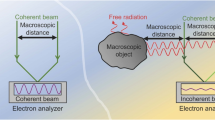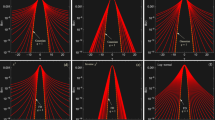Abstract
Quantum theory predicts the existence of the Casimir force between macroscopic bodies, a force arising from the zero-point energy of electromagnetic field modes around them. A thermal Casimir force, due to thermal rather than quantum fluctuations of the electromagnetic field at finite temperature, was theoretically predicted long ago. Here we report the experimental observation of the thermal Casimir force between two gold plates. We measured the attractive force between a flat and a spherical plate for separations between 0.7 μm and 7 μm. An electrostatic force caused by potential patches on the plates’ surfaces is included in the analysis. Previous measurements of the quantum-fluctuation-induced force have been unable to clearly settle the question of whether the correct low-frequency form of the dielectric constant dispersion for calculating Casimir forces is the Drude model or the plasma model. Our experimental results are in excellent agreement (reduced χ2 of 1.04) with the Casimir force calculated using the Drude model, including the T=300 K thermal force, which dominates over the quantum fluctuation-induced force at separations greater than 3 μm. The plasma model result is excluded in the measured separation range.
This is a preview of subscription content, access via your institution
Access options
Subscribe to this journal
Receive 12 print issues and online access
$209.00 per year
only $17.42 per issue
Buy this article
- Purchase on Springer Link
- Instant access to full article PDF
Prices may be subject to local taxes which are calculated during checkout



Similar content being viewed by others
References
Casimir, H. B. G. On the attraction between two perfectly conducting plates. Proc. K. Ned. Akad. Wet. 51, 793–795 (1948).
Sparnaay, M. Measurements of attractive forces between flat plates. Physica 24, 751–764 (1958).
Lamoreaux, S. K. Demonstration of the Casimir force in the 0.6 to 6 μm range. Phys. Rev. Lett. 78, 5–8 (1997).
Lamoreaux, S. K. Casimir forces: Still surprising after 60 years. Phys. Today 60, 40–45 (February, 2007).
Milonni, P. The Quantum Vacuum : An Introduction to Quantum Electrodynamics (Academic, 1994).
Bressi, G., Carugno, G., Onofrio, R. & Ruoso, G. Measurement of the Casimir force between parallel metallic surfaces. Phys. Rev. Lett. 88, 041804 (2002).
Derjaguin, B. V. Untersuchungen über die Reibung und adhäsion, IV. Kolloid-Z. 69, 155–164 (1934).
Blocki, J., Randrup, J., Swiatecki, W. J. & Tsang, C. F. Proximity forces. Ann. Phys. 105, 427–462 (1977).
Lifshitz, E. M. The theory of molecular attractive forces between solids. Sov. Phys. JETP 2, 73–83 (1956).
Sabisky, E. S. & Anderson, C. H. Verification of the Lifshitz theory of the van der Waals potential using liquid-helium films. Phys. Rev. A 7, 790–806 (1973).
Mohideen, U. & Roy, A. Precision measurement of the Casimir force from 0.1 to 0.9 μm. Phys. Rev. Lett. 81, 4549–4552 (1998).
Chan, H. B., Aksyuk, V. A., Kleiman, R. N., Bishop, D. J. & Capasso, F. Quantum mechanical actuation of microelectromechanical systems by the Casimir force. Science 291, 1941–1944 (2001).
Decca, R. S., López, D., Fischbach, E. & Krause, D. E. Measurement of the Casimir force between dissimilar metals. Phys. Rev. Lett. 91, 050402 (2003).
Kim, W. J., Sushkov, A. O., Dalvit, D. A. R. & Lamoreaux, S. K. Measurement of the short-range attractive force between Ge plates using a torsion balance. Phys. Rev. Lett. 103, 060401 (2009).
Feiler, A. A., Bergstrom, L. & Rutland, M. W. Superlubricity using repulsive van der Waals forces. Langmuir 24, 2274–2276 (2008).
Munday, J. N., Capasso, F. & Parsegian, V. A. Measured long-range repulsive Casimir–Lifshitz forces. Nature 457, 170–173 (2009).
Obrecht, J. M. et al. Measurement of the temperature dependence of the Casimir–Polder force. Phys. Rev. Lett. 98, 063201 (2007).
Bostrom, M. & Sernelius, B. E.. Thermal effects on the Casimir force in the 0.1–5 μm range. Phys. Rev. Lett. 84, 4757–4760 (2000).
Brevik, I., Aarseth, J. B., Hoye, J. S. & Milton, K. A. Temperature dependence of the Casimir effect. Phys. Rev. E 71, 056101 (2005).
Bezerra, V. B., Klimchitskaya, G. L., Mostepanenko, V. M. & Romero, C. Violation of the Nernst heat theorem in the theory of the thermal Casimir force between Drude metals. Phys. Rev. A 69, 022119 (2004).
Decca, R. S. et al. Precise comparison of theory and new experiment for the Casimir force leads to stronger constraints on thermal quantum effects and long-range interactions. Ann. Phys. 318, 37–80 (2005).
Kittel, C. & Kroemer, H. Thermal Physics (W. H. Freeman, 1980).
Langer, S. A. & Sethna, J. P. Entropy of glasses. Phys. Rev. Lett. 61, 570–573 (1988).
Intravaia, F. & Henkel, C. Casimir interaction from magnetically coupled eddy currents. Phys. Rev. Lett. 103, 130405 (2009).
Robertson, N. A. et al. Kelvin probe measurements: Investigations of the patch effect with applications to ST-7 and LISA. Class. Quantum Gravity 23, 2665–2680 (2006).
Robertson, N. A. Report LIGO-G070481-00-R (available at http://www.ligo.caltech.edu/docs/G/G070481-00.pdf) (2007).
Antonini, P. et al. An experimental apparatus for measuring the Casimir effect at large distances. J. Phys. Conf. Ser. 161, 012006 (2009).
Speake, C. C. & Trenkel, C. Forces between conducting surfaces due to spatial variations of surface potential. Phys. Rev. Lett. 90, 160403 (2003).
Kim, W. J., Sushkov, A. O., Dalvit, D. A. R. & Lamoreaux, S. K. Surface contact potential patches and Casimir force measurements. Phys. Rev. A 81, 022505 (2010).
Lamoreaux, S. K. Reanalysis of Casimir force measurements in the 0.6-to-6-μm range. Phys. Rev. A 82, 024102 (2010).
Yashchuk, V. V. et al. Surface roughness of stainless-steel mirrors for focusing soft X rays. Appl. Opt. 45, 4833–4842 (2006).
Yashchuk, V. V. et al. in Nano- and Micro-Metrology Vol. 5858 (eds Ottevaere, H., DeWolf, P. & Wiersma, D. S.) 58580A-12 (SPIE,2005).
Rossi, F. Contact potential measurement: Spacing-dependence errors. Rev. Sci. Instrum. 63, 4174–4181 (1992).
Cheran, L., Johnstone, S., Sadeghi, S. & Thompson, M. Work-function measurement by high-resolution scanning Kelvin nanoprobe. Meas. Sci. Technol. 18, 567–578 (2007).
Palik, E. D. (ed.) Handbook of Optical Constants of Solids (Academic, 1998).
Acknowledgements
The authors thank V. Yashchuk for performing the surface roughness measurements, and acknowledge discussions with S. Eckel and F. Intravaia. This work was supported by the DARPA/MTOs Casimir Effect Enhancement project under SPAWAR Contract No. N66001-09-1-2071.
Author information
Authors and Affiliations
Contributions
A.O.S. performed data analysis and prepared the manuscript. W.J.K. carried out optical property measurements, theoretical force calculations, and programming for data acquisition. D.A.R.D. provided theoretical support and calculations. S.K.L. performed data acquisition, programming and calibrations.
Corresponding author
Ethics declarations
Competing interests
The authors declare no competing financial interests.
Rights and permissions
About this article
Cite this article
Sushkov, A., Kim, W., Dalvit, D. et al. Observation of the thermal Casimir force. Nature Phys 7, 230–233 (2011). https://doi.org/10.1038/nphys1909
Received:
Accepted:
Published:
Issue Date:
DOI: https://doi.org/10.1038/nphys1909
This article is cited by
-
Casimir forces out of thermal equilibrium near a superconducting transition
Scientific Reports (2022)
-
The Repulsive Casimir-Type Forces of a Weakly Interacting Bose–Einstein Condensate Gas
Journal of Low Temperature Physics (2022)
-
Strong geometry dependence of the Casimir force between interpenetrated rectangular gratings
Nature Communications (2021)
-
Measurement of gravitational coupling between millimetre-sized masses
Nature (2021)
-
Casimir-Like Effect from Thermal Field Fluctuations
Brazilian Journal of Physics (2021)



